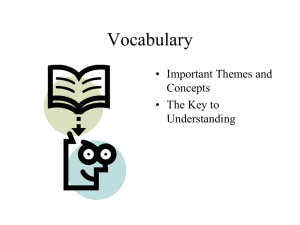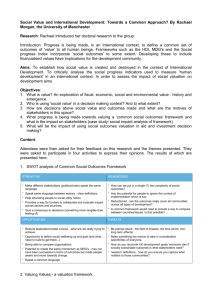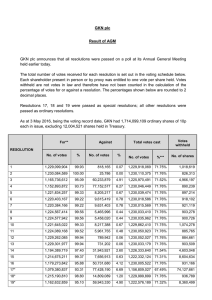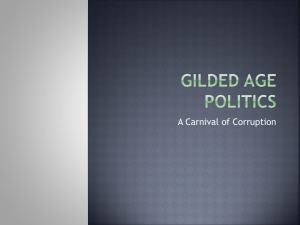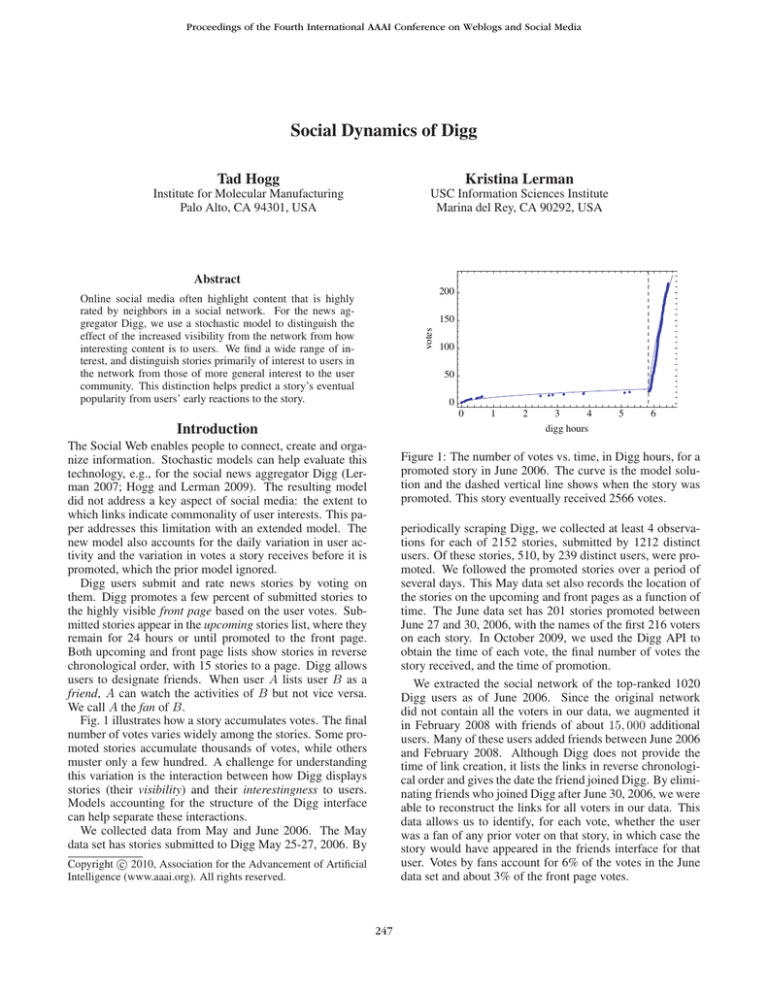
Proceedings of the Fourth International AAAI Conference on Weblogs and Social Media
Social Dynamics of Digg
Tad Hogg
Kristina Lerman
Institute for Molecular Manufacturing
Palo Alto, CA 94301, USA
USC Information Sciences Institute
Marina del Rey, CA 90292, USA
Abstract
200
Online social media often highlight content that is highly
rated by neighbors in a social network. For the news aggregator Digg, we use a stochastic model to distinguish the
effect of the increased visibility from the network from how
interesting content is to users. We find a wide range of interest, and distinguish stories primarily of interest to users in
the network from those of more general interest to the user
community. This distinction helps predict a story’s eventual
popularity from users’ early reactions to the story.
votes
150
100
50
0
0
Introduction
1
2
3
4
5
6
digg hours
The Social Web enables people to connect, create and organize information. Stochastic models can help evaluate this
technology, e.g., for the social news aggregator Digg (Lerman 2007; Hogg and Lerman 2009). The resulting model
did not address a key aspect of social media: the extent to
which links indicate commonality of user interests. This paper addresses this limitation with an extended model. The
new model also accounts for the daily variation in user activity and the variation in votes a story receives before it is
promoted, which the prior model ignored.
Digg users submit and rate news stories by voting on
them. Digg promotes a few percent of submitted stories to
the highly visible front page based on the user votes. Submitted stories appear in the upcoming stories list, where they
remain for 24 hours or until promoted to the front page.
Both upcoming and front page lists show stories in reverse
chronological order, with 15 stories to a page. Digg allows
users to designate friends. When user A lists user B as a
friend, A can watch the activities of B but not vice versa.
We call A the fan of B.
Fig. 1 illustrates how a story accumulates votes. The final
number of votes varies widely among the stories. Some promoted stories accumulate thousands of votes, while others
muster only a few hundred. A challenge for understanding
this variation is the interaction between how Digg displays
stories (their visibility) and their interestingness to users.
Models accounting for the structure of the Digg interface
can help separate these interactions.
We collected data from May and June 2006. The May
data set has stories submitted to Digg May 25-27, 2006. By
Figure 1: The number of votes vs. time, in Digg hours, for a
promoted story in June 2006. The curve is the model solution and the dashed vertical line shows when the story was
promoted. This story eventually received 2566 votes.
periodically scraping Digg, we collected at least 4 observations for each of 2152 stories, submitted by 1212 distinct
users. Of these stories, 510, by 239 distinct users, were promoted. We followed the promoted stories over a period of
several days. This May data set also records the location of
the stories on the upcoming and front pages as a function of
time. The June data set has 201 stories promoted between
June 27 and 30, 2006, with the names of the first 216 voters
on each story. In October 2009, we used the Digg API to
obtain the time of each vote, the final number of votes the
story received, and the time of promotion.
We extracted the social network of the top-ranked 1020
Digg users as of June 2006. Since the original network
did not contain all the voters in our data, we augmented it
in February 2008 with friends of about 15, 000 additional
users. Many of these users added friends between June 2006
and February 2008. Although Digg does not provide the
time of link creation, it lists the links in reverse chronological order and gives the date the friend joined Digg. By eliminating friends who joined Digg after June 30, 2006, we were
able to reconstruct the links for all voters in our data. This
data allows us to identify, for each vote, whether the user
was a fan of any prior voter on that story, in which case the
story would have appeared in the friends interface for that
user. Votes by fans account for 6% of the votes in the June
data set and about 3% of the front page votes.
c 2010, Association for the Advancement of Artificial
Copyright Intelligence (www.aaai.org). All rights reserved.
247
parameter
average rate each user visits Digg
number of active users
fraction viewing upcoming pages
page view distribution
probability a user is a voter’s fan
upcoming stories location
front page location
Social Dynamics of Digg
We extend the previous stochastic model (Hogg and Lerman
2009) to distinguish votes from fans and non-fans. We take
the number of users to be constant over our short sample
period. Activity on Digg varies considerably over the course
of a day, so we define the “digg time” between two events
as the number of votes on front page stories between those
events (Szabo and Huberman 2008). We scale the measure
by defining a “Digg hour” to be the average number of front
page votes in an hour, i.e., 2500 for our data set. This gives
the average rates of growth for votes from fans and non-fans
of prior voters, vF and vN , respectively as:
value
ω = 0.2 /hr
U = 70, 000
c = 0.065
μ = 6.3, λ = 0.14
ρ = 9.48 × 10−6
ku = 3.60 pages/hr
kf = 0.18 pages/hr
Table 1: Model parameters, with times in “Digg hours”.
number of votes a story has when promoted with a logistic
regression to define P (v), in contrast to the prior use of a
step function at 40 votes (Hogg and Lerman 2009).
dvN
dvF
= ωrF PF F and
= ωrN PN N
dt
dt
where t is the Digg time since the story’s submission and ω
is the average rate a user visits Digg. vN includes the story’s
submitter. PF and PN denote the story’s visibility and rF
and rN denote the story’s interestingness to users who are
fans or not of prior voters, respectively. Visibility depends
on the story’s state (e.g., whether it has been promoted), as
discussed below. Interestingness is the probability a user
who sees the story will vote on it. Nominally people become
fans of those whose contributions they consider interesting,
suggesting fans likely have higher interest in stories.
These voting rates depend on F (N ), the numbers of users
who have not yet seen the story and who are (are not) fans
of prior voters. The quantities change according to
Since we observe votes, not visits to Digg, there is some
ambiguity in the values ω and rF , rN , which appear only as
products in the rate equations. This arbitrary scaling does
not affect the relative behavior of fans and non-fans, so for
definiteness we pick a specific value for ω. We used the May
data to estimate ku and kf , which correspond to 54 and 2.7
stories per hour submitted and promoted, respectively.
We use the non-fan votes for 16 stories in the June data
set to estimate c and the “law of surfing” parameters μ and
λ by maximum likelihood. We then use fan votes for these
stories to evaluate ρ.
Our model involves a population of “active users” during
our sample period. We do not observe visits in our data,
but can infer the number of active users, U , from the heterogeneity in the number of votes by users. The June data
set consists of 16283 users who voted at least once. Fig. 2
shows the distribution of this activity on front page stories.
Most users have little activity, suggesting a large fraction
of users vote infrequently enough to never have voted during our data sample. Users can be characterized by activity
rates. A user with activity rate ν will, on average, vote on
νT stories during a sample time T . We model the votes as
arising from a Poisson process with mean νT and the heterogeneity arising from a lognormal distribution of user activity
rates (Hogg and Szabo 2009). This model gives rise to the
extended activity distribution while accounting for the discrete nature of the observations. The latter is important for
the majority of users who have low activity rates so will vote
only a few times, or not at all, during our sample period. A
zero-truncated maximum likelihood estimate (Hilbe 2008)
fits this model to the vote distribution of Fig. 2, giving νT
lognormally distributed with the mean and standard deviation of log(νT ) equal to −2.06 ± 0.03 and 1.82 ± 0.03, respectively. Based on this fit, the curve in Fig. 2 shows the expected number of users with each number of votes. A bootstrap test (Efron 1979) based on the Kolmogorov-Smirnov
(KS) statistic shows the vote counts are consistent with this
distribution (p-value 0.48). This test and the others reported
in this paper account for the fact that we fit the distribution
parameters to the data (Clauset, Shalizi, and Newman 2009).
This fit indicates about 3/4 of the users had sufficiently low,
but nonzero, activity rate that they did not vote during the
sample period. We use this value to estimate U .
dv
dF
= −ωPF F + ρN
dt
dt
dN
dv
= −ωPN N − ρN
dt
dt
where v = vF + vN and ρ is the probability a user who has
not yet seen the story and is not a fan of a prior voter is a
fan of the most recent voter. The first term in each equation
is the rate the users see the story. Table 1 lists the model
parameters, estimated as described below.
Initially, the story has one vote (from the submitter) and
the submitter has S fans, so vF (0) = 0, vN (0) = 1, F = S
and N = U − S − 1 where U is the number of active users.
Over time, a story becomes less visible as it moves down the
upcoming or (if promoted) front page lists.
We assume a fan easily sees the story via the friends interface, so PF = 1. Other users must find the story so PN depends on how users navigate through the upcoming or front
page lists, i.e., the “law of surfing” (Huberman et al. 1998)
which gives an inverse Gaussian distribution of the number
of pages a user visits, with mean μ and variance μ3 /λ.
The page number of a story on the upcoming page q and
the front page p at time t is p = kf (t − Tpromotion ) + 1 and
q = ku t + 1 where Tpromotion is the story’s promotion time.
Upcoming stories are less popular than the front page, modeled by a fraction c < 1 of visitors viewing the upcoming
stories. Combining these effects gives a model of visibility (Hogg and Lerman 2009) which determines PN .
Promotion to the front page depends on the number of
votes, which we model by the probability P (v) a story is
promoted after its v th vote. We account for the spread in the
248
users with that many votes
104
first 216 votes
first 10 votes
1000
10
1
2
5
10
20
50
direct
extrapolation
21%
29%
Table 2: Prediction errors on whether a story receives at least
500 votes for three methods: 1) the full model which allows
distinct values for rF and rN , 2) the model constrained to
have rF = rN , and 3) direct extrapolation from the rate
the story accumulates votes. This comparison involves 178
promoted stories, of which 137 receive at least 500 votes.
100
1
model
distinct r same r
10%
12%
18%
23%
100
front page votes
2008) in two ways: 1) we extrapolate from the time required
for the story to acquire a given number of votes instead of
the number of votes at a given time, and 2) we use early
votes after submission (i.e., including when the story is upcoming, where the social network has a large effect) instead
of early votes after promotion.
In the case of prediction based on the first 10 votes, which
is before the stories are promoted, an additional question is
how well the model predicts whether the story will eventually be promoted. We find a 25% error rate in predicting
promotion based on the first 10 votes.
We can improve predictions from early votes by using the
lognormal distributions of rF and rN as the prior probability
to combine with the likelihood from the data with Bayes theorem. Using this prior gives little change in rN , due to the
many non-fan votes on each story, but makes large changes
in some of the rF estimates. For example, when predicting based on the first 10 votes, using this prior increases
the Spearman rank correlation between predicted and actual
number of votes from 0.46 to 0.53. For comparison, this correlation for extrapolation from the first 10 votes is 0.32 and
is 0.34 for the model constrained to have rF = rN . Pairwise
bootstrap tests indicate the differences between these values
are significant with p-values less than 0.01.
A previous study showed stories initially receiving a small
proportion of votes from fans became much more popular
than stories which had a high proportion of such votes (Lerman and Galstyan 2008). That work exploited social influence only to make the prediction, and the results were not
applicable to stories submitted by poorly connected users
which were not quickly discovered by highly connected
users. In contrast, the approach described in this paper considers effects of social influence regardless of the connectedness of the submitter, and also accounts for story quality. Fig. 3 shows our model explains this relationship, which
arises from the difference in interestingness for fans and
non-fans. Specifically, a low fraction of early votes by fans
indicates rN is relatively large to produce the early nonfan votes in spite of the lower visibility of upcoming stories to non-fan users. Once the story is promoted, it then
receives relatively more votes from the general user community (most of whom are not fans of prior voters). The
separation of effects of visibility and interestingness with
our model improves this discrimination compared to just using the raw number of votes by fans and non-fans without
regard for the story visibility at the time of the votes. For
example, the correlation between the final number of votes
Figure 2: User activity distribution on logarithmic scales.
The curve shows the fit to the model described in the text.
Results
We find a wide range of interestingness: the rN values fit
well to a lognormal distribution with mean and standard deviation of log(rN ) equal to −4.0 ± 0.1 and 0.63 ± 0.07,
respectively, with the ranges giving the 95% confidence intervals. A bootstrap test based on the KS statistic shows the
r values are consistent with this distribution (p-value 0.1).
The rF values are approximately lognormally distributed
with mean and standard deviation of log(rF ) equal to
−1.8 ± 0.1 and 0.75 ± 0.08, respectively. The KS statistic indicates a weaker fit, with a p-value of 0.04.
We find large variation in the ratio rF /rN : ranging from
0 to 87, with median 9.3. The high values correspond to
stories that get only a few votes, indicating they are of significantly more interest to the fans of voters than to the general user population, i.e., “niche interest” stories. Overall,
there is little relation between how interesting a story is to
fans and other users: the correlation between rF and rN is
−0.11. A randomization test indicates this small correlation
is only marginally significant, with p-value 0.05 of arising
from uncorrelated values. Stories with high ratios of rF /rN
tend to be promoted after fewer votes than those stories with
low ratios.
Predicting popularity in social media from intrinsic properties of newly submitted content is difficult (Salganik,
Dodds, and Watts 2006). However, users’ early reactions give some predictability (Hogg and Szabo 2009;
Kaltenbrunner, Gomez, and Lopez 2007; Lerman and Galstyan 2008; Szabo and Huberman 2008). As one example,
we evaluate whether a story receives at least 500 votes. Table 2 compares the predictions with different methods, including a constrained version of our model with rF = rN ,
which assumes no systematic difference in interest between
fans and other users. For comparison, direct extrapolation
from the v votes observed at early time t gives vtfinal /t,
where we take tfinal to be 72 hours, a time by which stories
have accumulated all, or nearly all, the votes they will ever
get. We use a least squares linear fit between these observed
and extrapolated values as the prediction. A pairwise bootstrap test indicates the model has a lower prediction error
than this extrapolation with p-value of 10−2 . This extrapolation method differs from a prior study (Szabo and Huberman
249
2500
on whether they are linked to users who submitted or previously rated the content, could apply to many such web sites.
final votes
2000
References
1500
Bakshy, E.; Karrer, B.; and Adamic, L. A. 2009. Social influence and the diffusion of user-created content. In Proc. of
the 10th ACM Conf. on Electronic Commerce (EC09), 325–
334. NY: ACM.
Clauset, A.; Shalizi, C. R.; and Newman, M. E. J. 2009.
Power-law distributions in empirical data. SIAM Review
51:661–703.
Crane, R., and Sornette, D. 2008. Viral, quality, and junk
videos on YouTube: Separating content from noise in an
information-rich environment. In Lerman, K., et al., eds.,
Proc. of the AAAI Symposium on Social Information Processing, 18–20.
Efron, B. 1979. Bootstrap methods: Another look at the
jackknife. Annals of Statistics 7:1–26.
Hilbe, J. M. 2008. Negative Binomial Regression. Cambridge Univ. Press.
Hogg, T., and Lerman, K. 2009. Stochastic models of usercontributory web sites. In Proc. of the Third International
Conference on Weblogs and Social Media (ICWSM2009),
50–57. AAAI.
Hogg, T., and Szabo, G. 2009. Diversity of user activity
and content quality in online communities. In Proc. of the
Third International Conference on Weblogs and Social Media (ICWSM2009), 58–65. AAAI.
Huberman, B. A.; Pirolli, P. L. T.; Pitkow, J. E.; and Lukose,
R. M. 1998. Strong regularities in World Wide Web surfing.
Science 280:95–97.
Kaltenbrunner, A.; Gomez, V.; and Lopez, V. 2007. Description and prediction of slashdot activity. In Proc. 5th
Latin American Web Congress (LA-WEB 2007).
Konstan, J. A.; Miller, B. N.; Maltz, D.; Herlocker, J. L.;
Gordon, L. R.; and Riedl, J. 1997. GroupLens: Applying
collaborative filtering to Usenet news. Communications of
the ACM 40(3):77–87.
Lerman, K., and Galstyan, A. 2008. Analysis of social voting patterns on Digg. In Proceedings of the 1st ACM SIGCOMM Workshop on Online Social Networks.
Lerman, K. 2007. Social information processing in social
news aggregation. IEEE Internet Computing: special issue
on Social Search 11(6):16–28.
Salganik, M. J.; Dodds, P. S.; and Watts, D. J. 2006. Experimental study of inequality and unpredictability in an artificial cultural market. Science 311:854–856.
Szabo, G., and Huberman, B. A. 2008. Predicting the popularity of online content. Technical report, HP Labs. Available at hpl.hp.com/research/scl/papers/predictions.
Wilkinson, D. M. 2008. Strong regularities in online peer
production. In Proc. of the 2008 ACM Conference on ECommerce, 302–309.
Wu, F., and Huberman, B. A. 2007. Novelty and collective
attention. Proc. of the Natl. Acad. Sci. 104:17599–17601.
1000
500
0
0.0
0.2
0.4
0.6
0.8
fraction of first 10 votes by fans
Figure 3: Relation between final number of votes and the
fraction of votes by fans among a story’s first 10 votes.
Small points are individual stories and the large points are
the mean values for each number of votes by fans. The curve
shows the model prediction.
and rN /rF is 0.72 compared to 0.64 for the correlation between the final number of votes and the ratio of non-fan to
fan votes.
Discussion
The broad distributions of popularity and user activity on
many social media sites can arise from simple macroscopic
dynamical rules (Wilkinson 2008). A phenomenological
model of the collective attention on Digg describes the distribution of final votes for promoted stories through a decay
of interest in news articles (Wu and Huberman 2007). Our
models offers an alternative explanation for the vote distribution from the combination of variation in the stories’ inherent interest to users and effects of user interface. Crane
and Sornette (2008) found dynamics was linked to the quality of videos on YouTube. While these studies aggregated
data from tens of thousands of individuals, our method focuses instead on the microscopic dynamics, modeling how
individual behavior contributes to content popularity.
Early and late popularity are correlated on Slashdot (Kaltenbrunner, Gomez, and Lopez 2007), Digg and
YouTube (Szabo and Huberman 2008). The niche interest
of content spread mainly via the social network is also seen
in Second Life (Bakshy, Karrer, and Adamic 2009).
By accounting for visibility, our model identifies stories
of high interest to fans. This could help highlight stories
in the friends interface, and recommend new fans to users,
based on visibility-adjusted similarity in voting rather than,
as commonly done in collaborative filtering (Konstan et al.
1997), just the number of similar votes. We find a wide range
of interestingness ratios between fans and non-fans. This explains prior observations that relatively high votes from fans
indicate stories are of niche interest. For more precise estimates of interestingness, the web site could track the fraction
of users seeing the story that vote for it.
User-contributory web sites typically allow users to designate others whose contributions they find interesting, and the
sites highlight the activity of linked users. Thus our stochastic model, explicitly distinguishing behavior of users based
250



